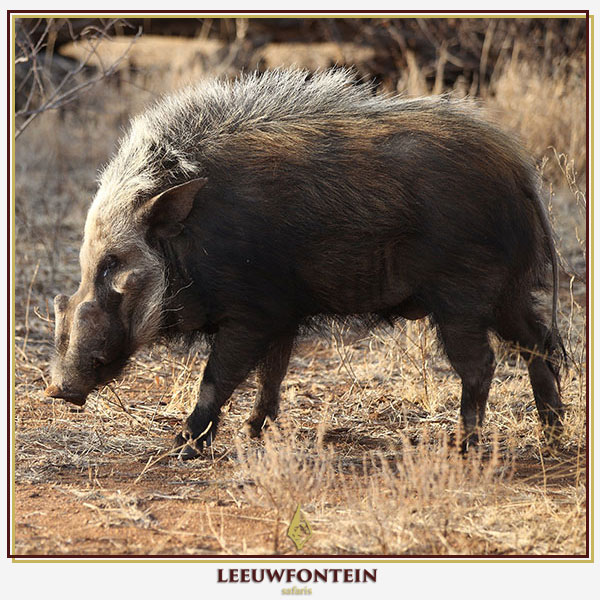The bushpig (Potamochoerus larvatus) is a robust and elusive member of the pig family native to sub-Saharan Africa, including South Africa. Resembling the European wild boar in appearance and behavior, bushpigs present a unique and challenging quarry for hunters. This comprehensive profile delves into the physical characteristics, trophy considerations, behavior, habitat, hunting strategies, recommended equipment, shot placement, and ethical hunting practices associated with pursuing bushpigs in South Africa.? game4africa.co.za +4
Bushpigs are medium to large-sized omnivores characterized by their stocky build and coarse hair. Adults typically stand between 66 to 100 centimeters at the shoulder, with body lengths ranging from 130 to 170 centimeters. Mature males, known as boars, can weigh up to 150 kilograms, while females are generally smaller, averaging around 55 to 70 kilograms.
heir coloration varies from reddish-brown to dark brown or black, often with lighter hair on the mane. Distinctive facial markings include a lighter-colored muzzle and cheek areas, with tufted, pointed ears. Both sexes possess sharp tusks, with the lower tusks being more prominent and measuring up to 7 centimeters in length. These tusks are formidable weapons, capable of inflicting serious injuries when the animal is threatened or wounded.?
For hunters seeking to document their bushpig trophies, the Rowland Ward system provides specific measurement criteria. The primary focus is on the length and circumference of the tusks. A trophy bushpig typically has tusks measuring around 4 inches (approximately 10 centimeters) in length. Measuring should be conducted carefully to ensure accuracy, considering both the visible tusk and any portion embedded in the jaw.?
Bushpigs are predominantly nocturnal and highly social animals, often found in groups called sounders, consisting of 6 to 12 individuals. These groups are typically led by a dominant male and female, accompanied by other females and their offspring. ?
Their preferred habitats include dense thickets, riverine forests, swamps, reed beds, and areas with tall grass near water sources. They are also known to inhabit agricultural lands, where they can become a significant nuisance due to crop raiding. During the day, bushpigs rest in dense cover to avoid predators and human interaction, emerging at night to forage.
As omnivores, their diet is diverse, comprising roots, bulbs, fruits, grasses, insects, small reptiles, and carrion. They are notorious for their destructive feeding habits, often uprooting vegetation and causing substantial damage to crops such as maize, sugarcane, and various fruits. ?
Hunting bushpigs in South Africa is considered challenging due to their nocturnal behavior, keen senses, and preference for dense habitats. Several effective hunting methods include:
Baiting: This is the most common technique, involving the establishment of bait sites using fermented corn, kitchen scraps, or carrion to attract bushpigs. Hunters then wait in blinds positioned nearby, often equipped with artificial lighting to illuminate the area during nighttime hunts. ? Tinashe Group +2
Hound Hunting:Utilizing packs of trained hounds to track and flush bushpigs from their daytime resting areas is another effective method. This approach requires coordination and readiness, as bushpigs can be aggressive when cornered. ?
Spotlighting: This method involves scanning open fields and feeding areas at night with powerful spotlights to locate foraging bushpigs. Once identified, hunters can make a stealthy approach for a shot.
Regardless of the chosen method, hunters must exercise caution due to the bushpig's potential for aggression, especially when wounded or threatened.?
Selecting appropriate equipment is crucial for a successful and ethical bushpig hunt:
Caliber Recommendations:
A minimum caliber of .270 is recommended, using premium-grade ammunition with controlled expansion bullets to ensure sufficient stopping power and penetration.
Rifle Considerations:
A reliable, bolt-action rifle equipped with a quality scope capable of performing in low-light conditions is ideal. Given the nocturnal nature of bushpigs, optics with good light-gathering capabilities are advantageous.
Alternative Weapons:
Shotguns loaded with slugs are also effective, particularly in dense vegetation where close encounters are likely.
Accurate shot placement is vital to ensure a humane kill and reduce the risk of wounding an animal that could become dangerous:?
Vital Areas:
The optimal shot placement is in the bottom third of the animal, directly above the front shoulder, targeting the heart and lungs. This ensures a quick and ethical kill.
Avoid Head and Neck Shots:
These areas present smaller targets and higher risks of merely wounding the animal, leading to unnecessary suffering and potential danger to the hunter.
Follow-up Shots:
Hunters should be prepared to take follow-up shots if the initial shot does not incapacitate the bushpig immediately. Tracking a wounded bushpig can be hazardous due to their aggressive nature when injured.
The bushpig (Potamochoerus larvatus) is a challenging and rewarding species for hunters in South Africa. With its nocturnal habits, elusive nature, and potential for aggression, hunting bushpigs requires skill, patience, and proper preparation. By employing the right tactics—whether baiting, hunting with hounds, or spotlighting—and using the appropriate firearm and ammunition, hunters can maximize their success while ensuring an ethical and responsible approach.
Trophy hunters looking to record their success can adhere to Rowland Ward standards, while conservation-minded hunters can contribute to sustainable population management.
In the end, the pursuit of the bushpig is not just about the hunt—it is an experience that tests a hunter’s resilience and skill while fostering a deeper appreciation for South Africa’s diverse wildlife.

| # | NAME | |
| 1. | Species List | |